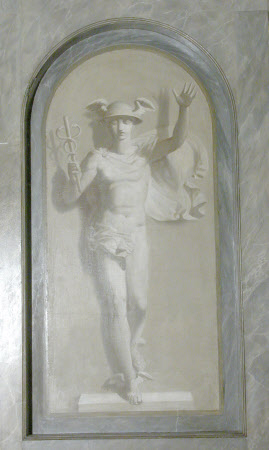Mercury
attributed to George Barret the Younger (London 1767 - London 1842)
Category
Art / Oil paintings
Date
c. 1812
Materials
Oil on canvas
Measurements
2007 x 927 mm (79 x 36 1/2 in)
Order this imageCollection
Attingham Park, Shropshire
NT 609087
Caption
This is one of three grisailles (monochrome painting simulating sculpture), which were all later additions to the Entrance Hall at Attingham. When the painted marbling of the Entrance Hall was restored, two concealed signatures of W & G Barret were discovered, one dated 1812. It is not clear whether these were two sons of the popular Irish-born landscape painter George Barret Senior (1728/32 – 1784), or two decorative painters, of which otherwise nothing is known. Mercury was one of the twelve Olympian gods, shown here in his role as messenger of the gods, wearing his winged sandals and helmet. He holds a caduceus, a wand with snakes entwined, which had the power to induce sleep.
Summary
Oil painting on canvas, Mercury, attributed to William Barret and George Barret the younger (London c.1767 - London 1842), circa 1812. Arched grisaille panel with the full-length figure of the Roman god, Mercury standing with his right foot on a plinth, facing, his left hand raised up, his right hand holding a caduceus (the messenger’s wand with two entwined snakes) wearing a winged helmet, winged sandals, and a cloak which billows to the right and acts as a discreet covering from the left.
Provenance
2nd Lord Berwick collection; bequeathed to the National Trust with the estate, house and contents of Attingham by Thomas Henry Noel-Hill, 8th Baron Berwick (1877-1947) on 15th May 1953.
Credit line
Attingham Park, The Berwick Collection (National Trust)
Makers and roles
attributed to George Barret the Younger (London 1767 - London 1842), artist attributed to William Barrett, artist previously catalogued as attributed to Robert Fagan (1761 - Rome 1816), artist
